Historically speaking, and when women have given birth at home, the baby was born with the woman in an upright position. When childbirth moved into hospitals, the flat-on-the-back pose became the most common option, usually with the legs in stirrups. Delivery rooms were fitted like an OR. Through studies, we now know that women want a more home-like environment, but with a high standard of medical security. When it comes to birthing positions during active labor, most women prefer some form of upright position. Women describe a greater sense of being in control and involved.
The WHO recommends upright labor positions, “Women should not be encouraged to adopt a supine position during childbirth. She should be encouraged to adopt an upright position and be in movement during the active stage of labor.”
Recommendations from the Swedish National Board of Health and Welfare
- The woman should be discouraged from a supine position
- The maternity clinic should inform the woman of alternative birthing positions and, during labor, the midwife should facilitate mobility and the choice of birthing position
- With the exception of a supine position, the woman should be encouraged to adopt the birth position that she feels is most comfortable.
Experience from midwives shows that very few women actively opt to adopt a position with their legs in stirrups when giving birth. The women felt more emotionally vulnerable, uninvolved and not in control of the situation.
Consider which positions you think would best benefit you during childbirth. It can be difficult to decide what you want to do in advance, but it’s a good idea to give some thought to what might work best. You can always change your mind and you can be certain that the staff will help you to find different position during delivery. They are experts in this field.
It’s also good if you and your partner have shared your ideas about different birthing positions so that your partner is already prepared. You need to remember to change positions regularly during labor. It’s easy to stay in one position, even if you eventually feel uncomfortable. Your partner and the staff play an important role in helping you. No birthing position is comfortable all the time. Changing positions after 20–30 minutes is a good rule of thumb. It’s important that you listen to what your body wants.
Several advantages to an upright position
- Your delivery will go faster since your uterus can work more effectively, you will have the advantage of gravity and pressure on your cervix will be more intense. (If your birth is moving along too fast and you want to slow things down, then a supine position is best.)
- You can provide oxygen to yourself and your baby more easily; your breathing is more effective in an upright position. Think about singers. They would never lie on their backs and sing since they cannot breathe as efficiently in that position
- You reduce the risk of nausea and a dip in blood pressure
- It’s easier to find the right technique to push
- Studies indicate that women have a better experience when they give birth in an upright position.
Sources:
- Abascal, G., & Huss, M. S. (2018). Att föda. Bonnier Fakta.
